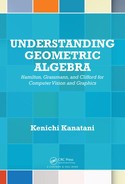
Preface
The aim of this boo k is to introduce geometric algebra, which recently has been attracting
attention in var ious domains of physics and engineering. For better understanding, emphasis
is on the background mathematics, including Ha milton algebra, Grassmann a lgebra, and
Clifford alge bra. These 19th century mathematics were almost forgotten in the 20 th century,
where the means for describing and computing geometry was mainly r e placed by vector and
tensor calculus and matrix computation based on linear algebra. In the late 20th century
and the early 21st century, however, scientists began to reevaluate these old mathematics
in a new light. A central figure among them is David Hestenes, an American physicist,
who called his formulation “geometric algebra” and actively disseminated it. This made
a big impact, not only on physicists but also on researchers of engineering applications,
including robotic arm control, computer graphics, and computer vision. It is expected that
this book will serve a wide range of people engaged in 3D modeling fo r computer graphics
and computer vision.
This book is intended mainly for engineering students higher at undergraduate and
graduate levels and for general researchers, but Chapter 2 describes the basis of 3D geometry
usually taug ht in first- or second-year undergraduate co urses of all science and engineering
departments. The description is detailed and fully comprehensive, so that this chapter can
serve as useful material for classes and exercises at lower undergraduate levels. In fact, this
chapter alone is almost sufficient for 3 D computation in most real applications, including
computer graphics and computer vision.
The author obtained extensive knowledge of classical geometry in the 1970s when he
was a graduate student of the (then) Department of Mathematical Engineering and Instru-
mentation Physics, the University of Tokyo, Japan, supervised by (late) Professor Nobunori
Oshima. The author still treasures to this day the thick volume of Lecture Notes on Geomet-
ric Mathematical Engineering of Professor Oshima, to whom the author dedicates this book.
He thanks Professor Shun-ichi Amari (currently at RIKEN, Japan), from whom the author
has received continuing guidance since his student days at the University of Tokyo. The
author also thanks many of his colleagues, including Leo Dorst of the University of Am-
sterdam, the Netherlands; Eduardo Bayro-Corrochano of CINVESTAV, Mexico; Vincent
Nozick of Universit´e Paris-E st, France; Wojciech Chojnacki of the University of Adelaide,
Australia; and Reinhard K lette of the University of Auckland, New Zealand, for reading
the raw manuscript of this book and giving helpful comments and suggestions.
xv
This page intentionally left blankThis page intentionally left blank
..................Content has been hidden....................
You can't read the all page of ebook, please click here login for view all page.
